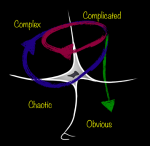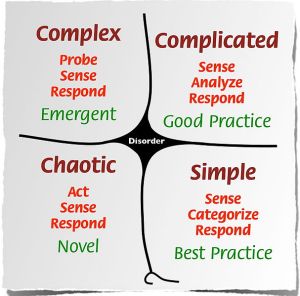I haven’t been posting for a while. The reason is that our first daughter was born in August and we are still overwhelmed with having a new person in our household. My work has been cut down to the minimum so we can cater to and at the same time hugely enjoy the new person in our lives.
Nevertheless, I have been doing some work. An interesting new avenue I am exploring is that of narrative sensemaking. Narrative inquiry has a long history and there are various branches to it. The branch I am exploring is based on the approach by Dave Snowden and his company Cognitive Edge, which attempts to collect metadata together with stories that can be analyzed statistically. This effectively adds a quantitative component to the otherwise purely qualitative nature of narrative inquiry.
As a first pilot we have added a narrative study to a larger thematic study on Regional Economic Development (RED). This thematic study is implemented by a consortium consisting of Mesopartner and SISTME for the Multilateral Investment Fund (MIF) of the Inter-American Development Bank. The goal of the narrative part of the study is to find factors that promote or hinder Local Economic Development initiatives to reach scale – either through effecting changes on policies or through a copying effect by other regions and actors.
Currently, we are collecting narratives from LED practitioners in Latin America. But we are also adding experiences from practitioners all around the world to get a richer picture and be able to compare the importance of the factors. We are using SurveyGizmo to collect the narratives. Although it does not allow for all the tricks as a specifically developed software like Cognitive Edge’s SenseMaker, we see it as a low-cost alternative to test the approach. We will know more about the suitability of the tool when we are done with the study. In any case we are eager to also use the more powerful SenseMaker Suite in upcoming projects and compare the functionality.
If you have made experiences in local and regional economic development that you would like to share, please fill out the questionnaire and share your story. You will have the chance to win a book voucher worth 75 USD. Here is the link to the three versions of the questionnaire we have: English, Spanish, Portuguese.


 For the last years I have had the privilege to take part of and contribute to Mesopartner’s journey into the field of complexity. We started to dismantle and question almost every aspect of our instruments, tools and theories. This journey has been very much in line with my own work, pondering how complexity theory can contribute to making economic development more effective and sustainable.
For the last years I have had the privilege to take part of and contribute to Mesopartner’s journey into the field of complexity. We started to dismantle and question almost every aspect of our instruments, tools and theories. This journey has been very much in line with my own work, pondering how complexity theory can contribute to making economic development more effective and sustainable. This is how a recent
This is how a recent  The last week of June I had the privilege of attending a three-day training event with Dave Snowden, founder of Cognitive Edge and “mental father” of the
The last week of June I had the privilege of attending a three-day training event with Dave Snowden, founder of Cognitive Edge and “mental father” of the